
The Nilgiri flowerpecker is a tiny bird in the flowerpecker family. Formerly a subspecies of what used to be termed as the plain flowerpecker although that name is now reserved for Dicaeum minullum. Like others of the group, it feeds predominantly on nectar and fruits. They forage within the canopy of forests and are found in India. They are non-migratory and the widespread distribution range includes several populations that are non-overlapping and morphologically distinct, some of which are recognized as full species. They are important pollinators and dispersers of mistletoes in forests.

The lilac-breasted roller is an African bird of the roller family, Coraciidae. It is widely distributed in sub-Saharan Africa, and is a vagrant to the southern Arabian Peninsula. It prefers open woodland and savanna, and it is for the most part absent from treeless places. Usually found alone or in pairs, it perches conspicuously at the tops of trees, poles or other high vantage points from where it can spot insects, lizards, scorpions, snails, small birds and rodents moving about on the ground. Nesting takes place in a natural hole in a tree where a clutch of 2–4 eggs are laid, and incubated by both parents, who are extremely aggressive in defence of their nest, taking on raptors and other birds. During the breeding season the male will rise to a fair height, descending in swoops and dives, while uttering harsh, discordant cries. The sexes are different in coloration, and juveniles lack the long tail streamers of adults. This species is unofficially considered the national bird of Kenya. Alternative names for the lilac-breasted roller include the fork-tailed roller, lilac-throated roller and Mosilikatze's roller.

The emerald toucanet or northern emerald toucanet is a species of near-passerine bird in the Ramphastidae family occurring in mountainous regions of Mexico and Central America.

The collaredaraçari is a toucan, a near-passerine bird. It breeds from southern Mexico to Panama; also Ecuador, Colombia, Venezuela and Costa Rica.

The white-cheeked barbet or small green barbet is a species of Asian barbet found in southern India. It is very similar to the more widespread brown-headed barbet, but this species has a distinctive supercilium and a broad white cheek stripe below the eye and is found in the forest areas of the Western Ghats, parts of the Eastern Ghats and adjoining hills. The brown-headed barbet has an orange eye-ring but the calls are very similar and the two species occur together in some of the drier forests to the east of the Western Ghats. Like all other Asian barbets, they are mainly frugivorous, and use their bills to excavate nest cavities in trees.

Meyer's parrot, also known as the brown parrot, is a species of parrot native to Africa. A Meyer's parrot has grey feathers, turquoise belly, blue rump, and bright yellow markings on the carpal joint of the wings. Most subspecies have some yellow on the top of the head as well. Forshaw (1989) recognizes six subspecies of P. meyeri which vary in home range, size and in markings, including the extent of yellow markings to the head and wings, and the intensity of turquoise markings on the belly and rump.
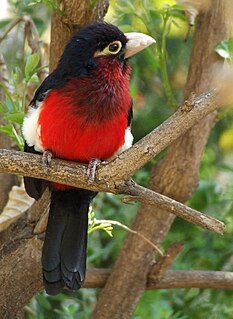
The African barbets are birds in the family Lybiidae. There are 43 species ranging from the type genus Lybius of forest interior to the tinkerbirds (Pogoniulus) of forest and scrubland. They are found throughout sub-Saharan Africa, with the exception of the far south-west of South Africa.

The streaky-headed seedeater or streaky-headed canary is a small passerine bird in the finch family. It is an unobtrusive but widespread species in suitable habitats of southern Africa. Its presence in an area is revealed foremost by its callnotes.
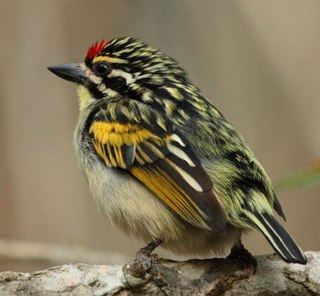
The red-fronted tinkerbird, is a small African barbet. Barbets are near-passerine birds with bristles around the base of the bill. They have a world-wide tropical distribution.

The racket-tailed roller is a species of bird in the family Coraciidae. It is found in southern Africa from Angola, south-eastern Democratic Republic of Congo and southern Tanzania to northern Botswana, Zimbabwe, Malawi and Mozambique.

The black-collared barbet is a species of bird in the family Lybiidae which is native to sub-Saharan Africa. Indigenous names include isiKhulukhulu and isiQonQotho in Zulu, and Isinagogo in Xhosa.

The yellow-rumped tinkerbird is a bird species in the family Lybiidae, which is native to the moist tropical and subtropical regions of sub-Saharan Africa.
The white-chested tinkerbird is a species of bird in the Lybiidae family . It is endemic to the Zambezian Cryptosepalum dry forests of Zambia. It is only known from the single type specimen, collected in 1964 by Jali Makawa, the field assistant and collector for Constantine Benson. Genetic evidence suggests that it may not be a separate species, but instead be a population embedded within the yellow-rumped tinkerbird if it is not an aberrant individual.

The speckled tinkerbird is a species of bird in the Lybiidae family.

The green tinkerbird is a species of bird in the Lybiidae family . It is found in Kenya, Malawi, Mozambique, and Tanzania.

The yellow-throated tinkerbird is a species of bird in the Lybiidae family.

The crested barbet is a sub-Saharan bird in the Lybiidae family. Its specific name commemorates François Levaillant, a famed French naturalist.
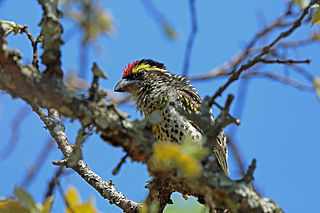
The miombo pied barbet is a species of bird in the family Lybiidae. It is found in south-central Africa.
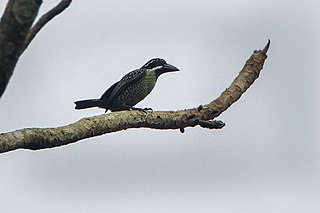
The hairy-breasted barbet is a species of bird in the family Lybiidae. It is found throughout the Africa tropical rainforest.
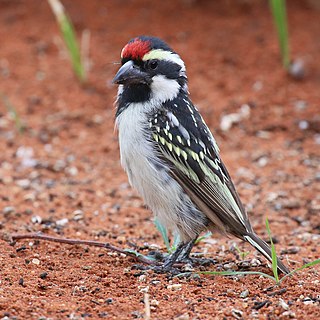
The acacia pied barbet or pied barbet is a species of bird in the family Lybiidae which is native to southern Africa.





















